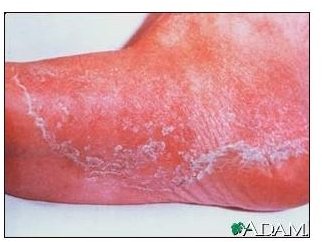Find a Natural Fix for Athlete's Foot

Athlete’s foot (tinea pedis) is the most common fungal infection of the skin caused by the tinea fungus. It mostly affects the area between the toes but can also occur on other parts of the foot. Symptoms include red, cracking and peeling skin, itching and burning.
The fungus thrives in warm, dark and moist environments, lives off of dead skin cells and affects men more than women. It is contagious and can spread to other parts of the body or to others through direct contact or through indirect contact such as shoes or shower surfaces.
Topical Treatments
Tea Tree Oil
Tea tree oil has been used for many years in Australia to treat skin infections. It has antifungal properties, and preliminary evidence suggests it might be helpful in the treatment of athlete’s foot. According to one double-blind, placebo-controlled study involving 158 participants, those who used tea tree oil had significantly better results than those who used a placebo: 64 percent of the people in the group who used a 50 percent tea tree oil solution were cured, 55 percent who used a 25 percent solution were cured, and only 31 percent in the placebo group were cured. To use, you can either rub some oil directly on your skin using gauze or a cotton ball, or (especially if the area is large) add 40 drops of oil to four cups of water and soak your foot in the solution for 10 minutes. Both remedies should be done twice a day.
Other
Other natural fungicides used to treat athlete’s foot include:
-
Sunlight - Expose your foot to sunlight every day for at least one hour.
-
Grapefruit Seed Extract - Apply a full strength extract to the affected area two to three times a day.
-
White or Apple Cider Vinegar - Add equal parts of water and vinegar and soak your foot in it for 15 minutes. Do this twice a day.
-
Ginger - Prepare two cups of strong ginger tea, pour in a basin of water and soak your foot for 15 minutes two times a day.
-
Cinnamon - Break 10 cinnamon sticks into pieces, add to four cups of water and bring to a boil. Reduce heat and simmer for five minutes. Remove from heat and steep for 45 minutes. Soak your foot for 30 minutes. Do this once a day.
-
Garlic - Crush a fresh garlic clove, apply it to the affected area, leave it on for about 30 minutes and rinse off with water. Do this once a day. Garlic can have a warm sensation but if it burns, wash it off immediately with cool water.
-
Onion - Squeeze the juice from a grated onion through a cheesecloth, massage the juice on the affected area, leave it on for 10 minutes and rinse off with water. Do this three times a day.
Diet
Diet plays an important role in the treatment of athlete’s foot. Eat a variety of fruits and vegetables, which are high in vitamin C and other antioxidants. Vitamin C is necessary for healthy skin and antioxidants boost the immune system so the body can fight the infection. Garlic and onions are particularly beneficial. If you wish to avoid garlic breath, you can take supplements. Increase your protein intake by eating lean meats, nuts and beans. Protein promotes healing by repairing skin tissue. Avoid sweets, which can delay the healing process.
Other Considerations
When treating athlete’s foot, and to help prevent recurrences:
-
Keep your feet clean. Wash twice a day with soap and water.
-
Completely dry your feet (including between the toes) after washing, soaking or swimming.
-
Wash your tub after bathing with an antiseptic cleaner.
-
Wear socks made of cotton to absorb sweat, and change at least once a day.
-
Wear shower shoes in public pools and showers.
-
Wear well ventilated shoes, preferably those made of natural material like leather. Plastic-lined shoes should be avoided.
-
Sprinkle some baking soda inside your shoes each night to dry up any moisture. It is best to wait 24 hours before wearing the same pair of shoes.
-
Wash your socks, as well as other clothes, in hot water and bleach to help kill the fungus.
When to Be Concerned
If the above natural fix for athlete’s foot does not work after one month, consult your health care provider.
Seek medical attention right away if you have a fever or your foot is warm to the touch, swollen, has red streaks or has a drainage like pus.
Speak to your doctor before treating if you have diabetes.
References
Medline Plus: https://www.nlm.nih.gov/medlineplus/ency/article/000875.htm
CVS/pharmacy: https://health.cvs.com/GetContent.aspx?token=f75979d3-9c7c-4b16-af56-3e122a3f19e3&chunkiid=21524
Joan Wilen and Lydia Wilen, Bottom Line’s Healing Remedies (2006)
Image courtesy of the National Library of Medicine (NLM)
Disclaimer
Please read this disclaimer regarding the information contained within this article.